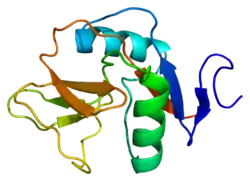Early Activation Antigen CD69
Early activation antigen CD69 ist ein Oberflächenprotein aus der Gruppe der Zelladhäsionsmoleküle.
| Early activation antigen CD69 | ||
|---|---|---|
 | ||
| nach PDB 1E87 | ||
| Andere Namen |
Activation inducer molecule, AIM | |
| Eigenschaften des menschlichen Proteins | ||
| Masse/Länge Primärstruktur | 199 Aminosäuren, 22.559 Da | |
| Bezeichner | ||
| Externe IDs | ||
| Orthologe (Mensch) | ||
| Entrez | 969 | |
| Ensembl | ENSG00000110848 | |
| UniProt | Q07108 | |
| Refseq (mRNA) | NM_001781.2 | |
| Refseq (Protein) | NP_001772.1 | |
| PubMed-Suche | 969 | |
Eigenschaften
CD69 wird von aktivierten T-Zellen, B-Zellen, NK-Zellen, Neutrophilen, Eosinophilen, Langerhans-Zellen und Thrombozyten gebildet. Es dient als Immunmodulator nach der Aktivierung.[1] CD69 bindet zweiwertige Calciumionen und ist glykosyliert und phosphoryliert.
Weblinks
Einzelnachweise
- D. Sancho, M. Gómez, F. Sánchez-Madrid: CD69 is an immunoregulatory molecule induced following activation. In: Trends in immunology. Band 26, Nummer 3, März 2005, S. 136–140, doi:10.1016/j.it.2004.12.006, PMID 15745855.
This article is issued from Wikipedia. The text is licensed under Creative Commons - Attribution - Sharealike. The authors of the article are listed here. Additional terms may apply for the media files, click on images to show image meta data.